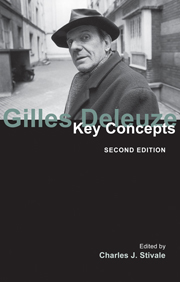4 - Desire
from PART I - PHILOSOPHIES
Summary
The aim of this essay is not to explain what desire means, but to show how the concept gets constructed and how it works. Creating concepts is the principal task of philosophy, and part of what this entails is extracting elements or dynamics from the works of other philosophers and combining them in new and productive ways. Perhaps surprisingly, but in fact like much in his work, Deleuze's concept of desire has its source in Kantian philosophy. But its construction also draws on elements from Bataille, Marx, Nietzsche, Spinoza and, of course, Freud and Lacan. Moreover, Deleuze historicizes the concept of desire in a manner that is crucial to the way it works.
Kant defines desire as “the faculty which by means of its representations is the cause of the actuality of the objects of those representations” (1911: 16). Whereas pure reason is concerned with how we can know objects, practical reason, Kant says in the second critique, “is concerned not with objects in order to know them, but with its own capacity to make them real” (2002: 14). At first glance, this is a bizarre claim for Kant to advance. How could practical reason alone possibly involve turning mental representations into reality? In what he calls its “pathological” mode, he acknowledges that it really can't; all it can do is produce a hallucinatory or delirious impression of reality.
- Type
- Chapter
- Information
- Gilles DeleuzeKey Concepts, pp. 55 - 64Publisher: Acumen PublishingPrint publication year: 2011



